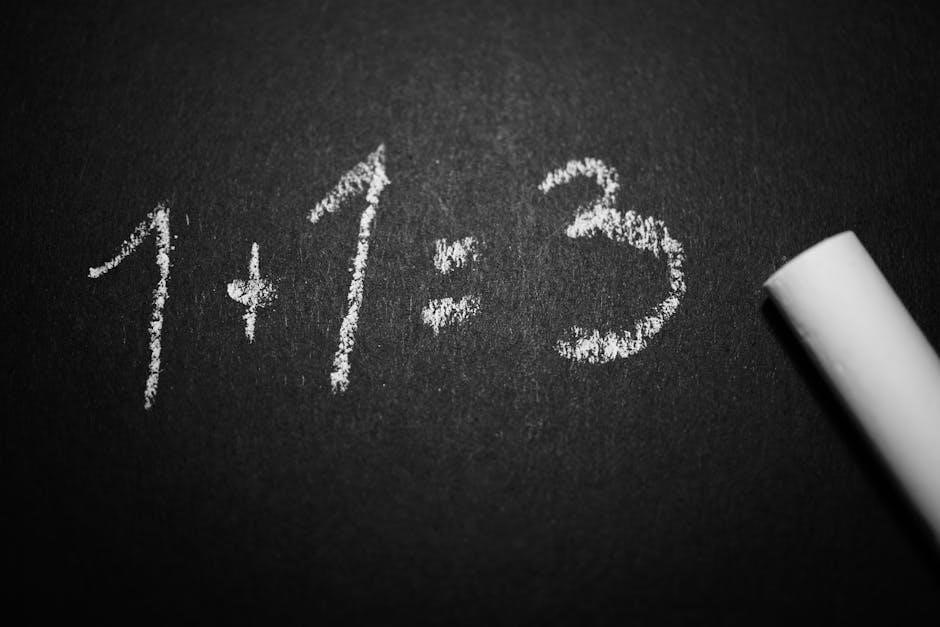
Year 3 Maths Booklet PDF: A Comprehensive Guide
This comprehensive guide explores the world of Year 3 Maths Booklets in PDF format. It highlights their importance in reinforcing classroom learning and providing extra practice. This guide will help parents and educators to find the perfect maths resources.
Year 3 marks a significant step in a child’s mathematical journey, building upon the foundational skills acquired in previous years. Students begin to tackle more complex concepts, solidifying their understanding of numbers, operations, and problem-solving strategies. The curriculum expands to include multiplication, division, fractions, and an introduction to more advanced geometrical concepts. Year 3 maths aims to foster not just computational fluency but also a deeper understanding of mathematical principles and their application in real-world scenarios.
The use of Year 3 Maths Booklets in PDF format serves as a valuable tool to support this learning process. These booklets provide structured practice, allowing children to reinforce their knowledge and develop confidence in their abilities. They often present concepts in a visually appealing and engaging manner, catering to different learning styles and keeping students motivated. With a focus on both accuracy and speed, Year 3 maths worksheets help students master the core skills that will be essential for future mathematical success.
Benefits of Using Maths Worksheets
Maths worksheets offer a myriad of benefits for Year 3 students. Regular practice with worksheets reinforces learned concepts, ensuring better retention and a deeper understanding of mathematical principles. These worksheets provide a structured approach to learning, allowing children to progressively build their skills from basic to more complex problems. The repetitive nature of worksheet exercises helps to improve computational fluency and accuracy, which are crucial for tackling more advanced maths in later years.
Furthermore, maths worksheets offer opportunities for independent learning and self-assessment. Students can work at their own pace, identifying areas where they need extra support and practicing until they achieve mastery. The availability of answer keys allows for immediate feedback, promoting self-correction and a sense of accomplishment. Worksheets also help develop problem-solving skills and logical reasoning, as students learn to apply their knowledge to different scenarios.
Year 3 maths worksheets are invaluable for supplementing classroom instruction and providing targeted practice to support individual learning needs.

Key Topics Covered in Year 3 Maths Booklets
Year 3 maths booklets comprehensively address key areas. These booklets cover addition, subtraction, multiplication, division, fractions, time, measurement and geometry. These topics build a strong foundation.
Addition and Subtraction
Addition and subtraction are fundamental skills reinforced in Year 3 maths booklets. Worksheets provide ample practice in adding and subtracting numbers, often involving 3-digit numbers. These exercises help children develop fluency and accuracy in performing calculations, building a solid foundation for more advanced mathematical concepts.
The booklets include various question types, starting with simpler problems and gradually increasing in difficulty. This progressive approach ensures that students can build their confidence and problem-solving skills. Word problems are also integrated, encouraging children to apply their addition and subtraction skills in real-world scenarios.
Furthermore, the worksheets may incorporate strategies such as using number lines, place value charts, and mental math techniques to aid understanding and promote efficient calculation. These strategies enhance children’s ability to visualize and manipulate numbers, fostering a deeper understanding of addition and subtraction. Regular practice with these booklets helps students develop a strong number sense and prepare them for future mathematical challenges. The focus is on both procedural fluency and conceptual understanding.
Multiplication and Division
Year 3 maths booklets dedicate a significant portion to multiplication and division, introducing children to the basics of these operations. Worksheets typically focus on learning multiplication tables up to 5 x 5, and sometimes extending to 10 x 10. The goal is to help children memorize these facts for quick recall.
The booklets also emphasize the relationship between multiplication and division, illustrating how they are inverse operations. Exercises involve solving simple multiplication and division problems, often presented in both numerical and word problem formats. These problems help children understand the practical applications of these operations.
Furthermore, the worksheets may introduce concepts such as repeated addition for multiplication and equal sharing for division. Visual aids and diagrams are often used to support understanding. The booklets also include activities that encourage children to explore patterns and relationships within multiplication tables. Regular practice with these booklets helps students develop a strong foundation in multiplication and division, preparing them for more complex problem-solving in the future. The focus is on building both fluency and conceptual understanding.
Fractions
Year 3 maths booklets introduce the foundational concepts of fractions, focusing on identifying and understanding simple fractions like halves, quarters, and thirds. Worksheets typically involve shading shapes to represent fractions, comparing fractions with the same denominator, and recognizing equivalent fractions.
The goal is to build a visual and conceptual understanding of what fractions represent. The booklets often use diagrams and illustrations to help children grasp the idea of dividing a whole into equal parts. Exercises may include activities where children have to divide objects or groups of objects into fractions.
Furthermore, worksheets may introduce adding and subtracting fractions with the same denominator, providing a gentle introduction to fraction arithmetic. Word problems are also included to help children understand the real-world applications of fractions. These problems may involve sharing food or measuring ingredients.
The booklets also aim to develop children’s ability to order fractions, focusing on fractions with small denominators. Regular practice with these booklets helps students develop a solid foundation in fractions, preparing them for more complex fraction operations in later years.
Time and Measurement
Year 3 maths booklets dedicate a significant portion to time and measurement, focusing on practical skills that children can apply in everyday life. Worksheets often involve reading and telling time on both analogue and digital clocks, including understanding units like seconds, minutes, hours, days, weeks, months, and years.
Measurement exercises include measuring length, mass, and capacity using standard units like centimetres, metres, grams, kilograms, and litres. The booklets provide opportunities to practice converting between different units of measurement. For example, converting centimetres to metres or grams to kilograms.
Practical problems are a key feature, where children are asked to solve real-life measurement scenarios. This may involve calculating the total length of several objects or working out the capacity of containers. Time-related problems could involve calculating elapsed time, such as determining how long an activity lasts or figuring out start and end times.
The booklets may also include activities related to using calendars and timetables. This could involve identifying dates, calculating the number of days between events, or interpreting information from a timetable. Regular practice with these skills helps children develop a strong sense of time and measurement, crucial for both academic and real-world applications.

Geometry and Shapes
Year 3 maths booklets often include geometry and shapes to enhance spatial reasoning and visual skills. Worksheets typically cover identifying and describing 2D shapes such as squares, rectangles, circles, triangles, pentagons, and hexagons. Children may be asked to name the shapes, count their sides and vertices, and identify any lines of symmetry.
The booklets introduce 3D shapes, including cubes, cuboids, spheres, cones, cylinders, and pyramids. Activities could involve matching shapes to real-world objects or drawing 3D shapes. Identifying properties like faces, edges, and vertices of 3D shapes is another common exercise.
Symmetry is a key concept, with worksheets asking children to identify lines of symmetry in different shapes. They might also be asked to complete symmetrical patterns or draw the other half of a symmetrical shape.
Position and direction are covered through activities involving describing the position of objects using terms like left, right, top, bottom, in front, and behind. Children might follow directions to move objects on a grid or describe a route.
Overall, geometry and shapes activities in Year 3 maths booklets aim to build a solid foundation in spatial awareness, shape recognition, and geometric vocabulary.

Types of Year 3 Maths Worksheets Available in PDF Format
Year 3 maths worksheets in PDF format come in two main types: printable and interactive. Printable worksheets are designed for physical completion, while interactive worksheets are completed on a screen, often with immediate feedback.
Printable PDF Worksheets
Printable PDF worksheets are a classic and readily accessible resource for Year 3 maths practice. These worksheets are designed to be downloaded, printed, and completed using traditional methods like pen or pencil. They offer a tangible learning experience, allowing children to physically engage with the problems.
These worksheets often cover a wide range of topics within the Year 3 maths curriculum, including addition, subtraction, multiplication, division, fractions, time, and geometry. They are structured to provide ample practice opportunities, reinforcing concepts learned in the classroom. The format typically includes a variety of question types, such as number problems, word problems, and visual representations.
Printable PDF worksheets are easily sourced from online educational websites, teacher resource platforms, and even free educational repositories. They are a cost-effective option, as they can be printed as needed, offering flexibility in lesson planning and homework assignments. Furthermore, they are compatible with most devices and printers, making them a convenient tool for both teachers and parents. The worksheets often include answer keys, which allow for easy checking and assessment of student progress.
Interactive On-Screen Worksheets
Interactive on-screen worksheets offer a modern and engaging approach to Year 3 maths practice. Unlike traditional printable PDFs, these worksheets are designed to be completed directly on a computer, tablet, or interactive whiteboard. This format often incorporates multimedia elements such as animations, interactive exercises, and immediate feedback.
These worksheets typically feature fill-in-the-blank questions, drag-and-drop activities, and interactive games that reinforce mathematical concepts. The interactive nature of these worksheets can help to capture children’s attention and maintain their engagement, making learning more enjoyable. Immediate feedback mechanisms allow students to instantly see if their answers are correct, promoting self-correction and independent learning.
Interactive on-screen worksheets are often available through online educational platforms, subscription services, or educational apps. They may require a stable internet connection and compatible software or browser. These worksheets can be a valuable tool for differentiating instruction, as they often provide options for adjusting the difficulty level and customizing the content. Additionally, some platforms offer tracking features that allow teachers and parents to monitor student progress and identify areas where additional support may be needed.

Resources for Finding Year 3 Maths Booklets PDF
Finding quality Year 3 maths booklets in PDF format is easier than ever. Explore online educational websites and marketplaces. These platforms offer a wealth of resources for parents and teachers alike.
Online Educational Websites
Numerous online educational websites serve as valuable resources for locating Year 3 maths booklets in PDF format. These websites often provide a curated selection of worksheets and resources. They are designed to align with the national curriculum. Look for websites that offer free downloads or affordable subscription options.
Many websites feature a variety of maths topics, including addition, subtraction, multiplication, division, fractions, and geometry. Some popular platforms include BBC Bitesize, Khan Academy, and Oxford Owl. These resources frequently offer interactive exercises, video tutorials, and printable worksheets. This makes them suitable for diverse learning styles.
When searching for resources, be sure to check the website’s credibility and ensure that the content aligns with the specific learning objectives for Year 3 maths. Look for websites that are recommended by teachers or educational experts. User reviews can also provide insight into the quality and effectiveness of the resources. Always prioritize sites with clear, concise, and engaging content. This will help children grasp mathematical concepts more effectively.
Teachers Pay Teachers and Similar Marketplaces
Teachers Pay Teachers (TpT) and other similar online marketplaces are excellent resources for finding Year 3 maths booklets in PDF format. These platforms host a vast collection of educational materials created by teachers and educators. They provide a diverse range of worksheets, activities, and complete booklets designed to support Year 3 maths learning.
These marketplaces offer a wide variety of resources catering to different learning styles and curriculum requirements. You can find booklets focused on specific topics such as multiplication facts, fractions, time, and geometry. Many resources are available for free, while others can be purchased at reasonable prices. This makes it easy to find materials that fit your budget and educational needs.
When using these marketplaces, be sure to carefully review the product descriptions and previews to ensure they meet your requirements. Read reviews from other users to get an idea of the quality and effectiveness of the resources. Consider factors such as clarity, alignment with curriculum standards, and engagement level. By carefully evaluating your options, you can find high-quality Year 3 maths booklets that will effectively support your child’s learning journey.